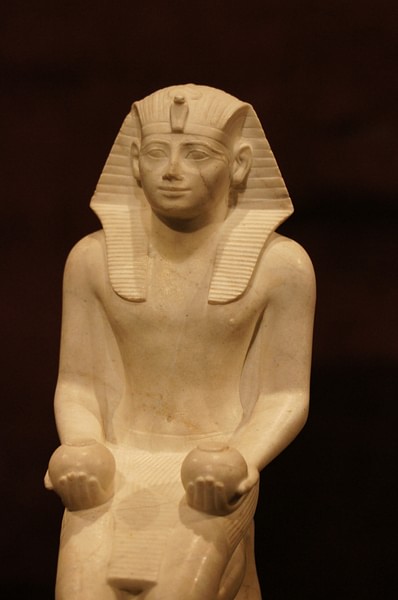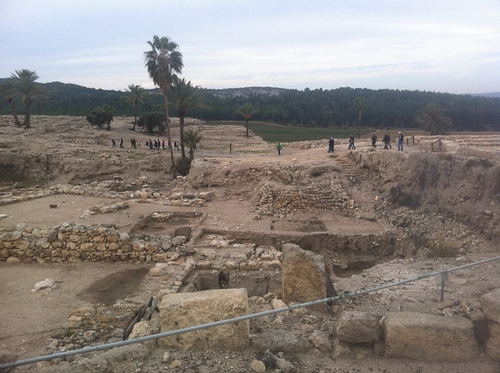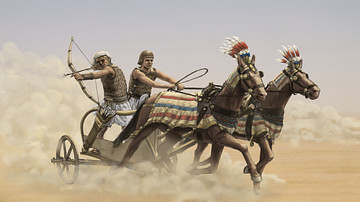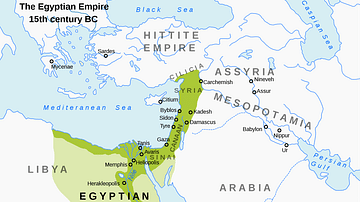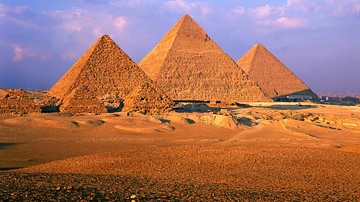The ancient site of Megiddo was the scene of a number of battles in antiquity and is best known as the source of the word armageddon, the Greek rendering of the Hebrew Har-Megiddo ('Mount of Megiddo') from the biblical Book of Revelation 16:16. Revelation 16:16 is the only use of the word in the Bible and designates the site of the final battle between the forces of the Christian god and those of his adversary Satan. Megiddo, however, is mentioned at least 12 times in the Hebrew scriptures (the Christian Old Testament) concerning a number of military conflicts between the Israelites and various opponents.
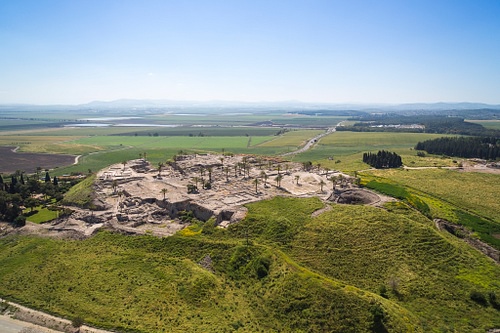
The Egyptian empire was initiated by Ahmose I (c.1570-1544 BCE) whose victory over the Hyksos of Lower Egypt marks the beginning of the period known as the New Kingdom of Egypt (c. 1570 - c. 1069 BCE), and every pharaoh who succeeded him maintained or enlarged the boundaries. Thutmose III, however, would go further than any others. In 20 years, he led 17 successful military campaigns, recorded on the walls of the Temple of Amun at Karnak but the most detailed account is of his first, and most famous, at Megiddo.
Background to the Battle
Thutmose III was the son and successor of Thutmose II (1492-1479 BCE), but when his father died, he was only three years old and so his step-mother, Hatshepsut (1479-1458 BCE), held the throne as regent. Soon after assuming this position, however, Hatshepsut broke with tradition and assumed power. Thutmose III spent his youth at the court of Thebes, in military training, and pursuing the kind of education expected for a prince of the New Kingdom.
After her first few years as pharaoh, Hatshepsut organized no major military campaigns but kept her forces at peak efficiency and, when he proved able, promoted Thutmose III to commander of her forces. She was one of the most powerful, resourceful, and efficient monarchs in Egypt's history and, when she died, left Thutmose III a prosperous country with a well-organized and highly-trained fighting force.
Hatshepsut had maintained the empire steadily throughout her reign, but when she died, the kings of Megiddo and Kadesh rebelled against her successor whom they seem to have believed was weak. It was actually fairly common in the ancient world for subject states to rise against a new ruler in order to take advantage of the transition of power to win their independence. It is possible, in fact, that Hatshepsut anticipated this in that there seems to be some evidence that Thutmose III's first campaign had been commissioned by her; this claim is disputed, however. The coalition between the Canaanites of Megiddo and the Syrians of Kadesh attracted others dissatisfied with Egyptian rule, who gathered their forces outside the city of Megiddo in late 1458 or early 1457 BCE.
The Battle of Megiddo
Thutmose III wasted no time in mobilizing his forces and marching from Thebes toward the city. The army covered 150 miles in 10 days and rested at Gaza before moving on to the town of Yehem where Thutmose III halted to confer with his senior staff. There were three roads they could take from the nearby town of Aruna to reach Megiddo: a narrow pass which would require the army to march in single file and two other broader roads which would enable faster and easier movement. The generals claimed they had intelligence that the enemy was waiting for them at the end of the narrow pass and, further, progress would be slow and difficult with the vanguard reaching the battle site while the rearguard was still on the march.
Thutmose III listened to their council but disagreed with their points. According to the record of the engagement kept by his military scribe Tjaneni, Thutmose III addressed his commanders, saying:
I swear, as Ra loves me, as my father Amun favors me, as my nostrils are rejuvenated with life and satisfaction, my majesty shall proceed upon this Aruna road! Let him of you who wishes go upon these roads of which you speak and let him of you who wishes come in the following of my majesty! 'Behold', they will say, these enemies whom Ra abominates, 'has his majesty set out on another road because he has become afraid of us?' – So they will speak. (Pritchard, 177)
The generals instantly bowed to his decision and then Thutmose III addressed his army. He encouraged them to march swiftly on the narrow road and assured them that he, himself, would lead from the front, saying "I will not let my victorious army go forth ahead of my majesty in this place!" (Pritchard, 177). The chariots and wagons were dismantled and carried and the men led the horses single-file through the pass to emerge in the Qina Valley by Megiddo.
They found no enemy waiting for them, and in fact, the coalition had assumed that Thutmose III would choose either of the easier routes and had troops prepared to defend at both locations. Thutmose III's decision to choose the more difficult path gave him the advantage of the element of surprise. He could not attack at once, however, since the better part of his army was still strung along the Aruna pass. It would take the rearguard over seven hours of marching to catch up with their king.
Thutmose III ordered the troops to rest and refresh themselves near the Qina Brook. Throughout the night, he personally received sentry reports and gave orders for the provisioning of the troops and their placement in battle for the following day. He positioned his army so that the southern wing was on a hill above the Qina Brook and the northern wing was on a rise to the northwest of Megiddo; the king would personally command the attack and lead from the center. Tjaneni's account reads:
His majesty set forth in a chariot of fine gold, adorned with his accoutrements of combat, like Horus, the Mighty of Arm, a lord of action like Montu, the Theban, while his father Amun made strong his arms…Thereupon his majesty prevailed over them at the head of his army. Then they [the enemy] saw his majesty prevailing over them and they fled headlong to Megiddo with their faces of fear. They abandoned their horses and their chariots of gold and silver so that someone might draw them up into this town by hoisting on their garments. Now the people had shut this town against them but they let down garments to hoist them up into this town. (Pritchard, 179)
Tjaneni's report notes how, if the army had pursued the fleeing enemy across the field and cut them down in their flight, then the battle would have ended decisively that day. Instead, the soldiers "gave up their hearts to capturing the possessions of the enemy" on the field and allowed their opponents to not only reach the sanctuary of the city but mount defenses (Pritchard, 179). Thutmose III ordered a moat dug around Megiddo and a stockade built around the moat. No one from inside the city was allowed out except to surrender or if called to parley by an Egyptian officer.
The siege lasted at least seven, possibly eight, months before the leaders of the coalition surrendered the city. Thutmose III offered very generous terms, which amounted to a promise from his opponents that they would not raise another rebellion against Egypt; none of the ringleaders were executed and the city was left untouched. Thutmose III did strip the ringleaders of their positions and appointed new officials, loyal to Egypt, in their place. He also took their children as hostages back to Egypt to guarantee their good behavior. Although this may sound harsh, the hostages were well cared for and continued to live at the level of comfort they were used to. The children were educated in Egyptian culture and, when they came of age, were sent back to their lands with an appreciation for and loyalty to the Egyptian pharaoh.
Significance of the Battle
The list of loot carried back to Egypt from the campaign, including prisoners of war, slaves, hostages, arms and armor, gold and silver chariots, jewels and precious metals, and livestock, would have been enough to mark it an overwhelming triumph. In addition to putting down the rebellion and enriching Egypt's treasury, however, the victory also gave Thutmose III control over northern Canaan and provided him with a base from which to launch campaigns into Mesopotamia. The great princes of the Mesopotamian cities which had not joined the coalition sent tribute to Egypt of their own accord to win favor with – and hopefully buy protection from - the great warrior-king and champion of The Battle of Megiddo, and his fame became legendary quite quickly.
In the following years, he would conquer Syria and the lands of the Mitanni – both of whom had been involved in the Megiddo uprising - before turning his attention to the southern borders of Egypt to defeat the Nubians and expand Egypt's holdings in that region. As at Megiddo, he always relied on the element of surprise and was never deterred by the difficulties or obstacles to victory. His triumph over the coalition at Megiddo established his reputation early and assured that the success of all his future campaigns was all but certain as the enemy would know in advance they were facing an invincible opponent.
The battle most likely suggested itself to the writer of Revelation in that the description of the forces of Satan and God in the biblical narrative are similar to those of the coalition and of Thutmose III's army in the official inscription of Tjaneni at Karnak. In both, the writers describe the victorious forces of good over the assembled coalition of evil. There can be little doubt that the scribe who wrote the biblical work was acquainted with The Battle of Megiddo since the story of Thutmose III's great victory against the combined forces of his enemies remained well known for centuries afterwards.
